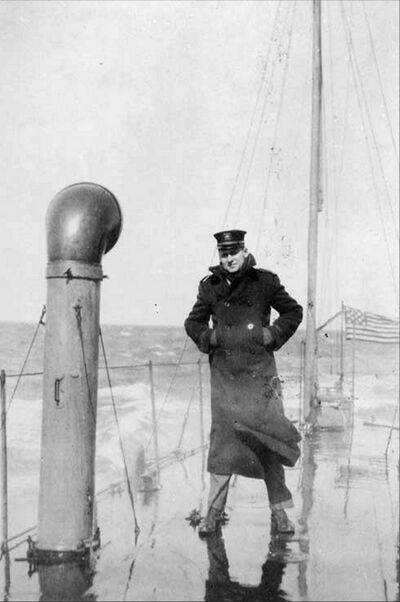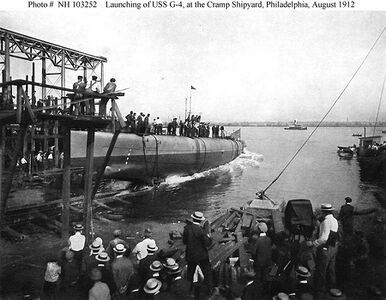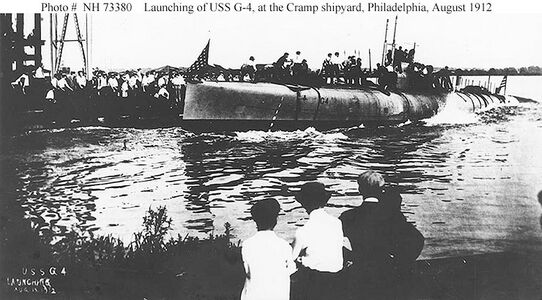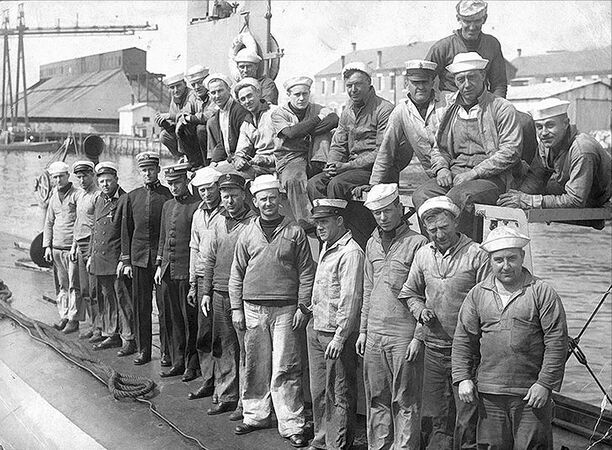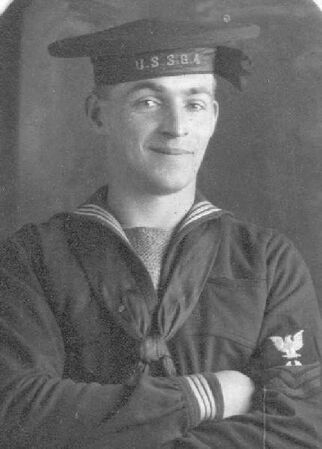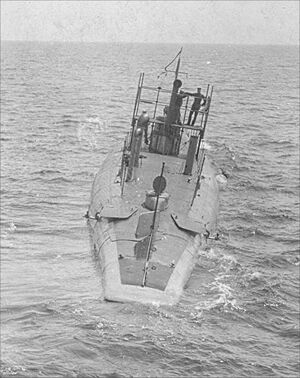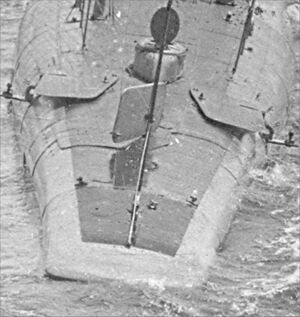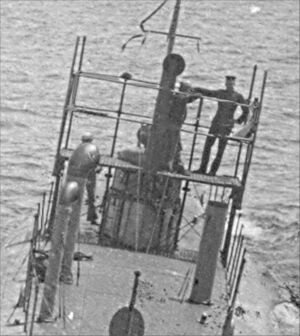G-4: Difference between revisions
Pbc captain (talk | contribs) No edit summary |
Pbcjohnston (talk | contribs) Reformatting G-4 page |
||
| Line 1: | Line 1: | ||
[[Category:G-4]] | [[Category:G-4]] | ||
[[File: | [[File:G-4_diagram.jpg|left|thumb|Drawing by Jim Christley, courtesy of Navsource.org]] | ||
<div style="text-align: justify;"><span style="color:#00008B">G-4 was an attempt to introduce competition to the submarine acquisition process in the years immediately before WWI. Authorized in Fiscal Year 1910 along with Lake's Turbot, Thrasher was built to an Italian design by naval architect Cesare Laurenti, whose boats for the Italian Navy had gained some recognition. Laurenti contracted with the William Cramp & Sons Shipbuilding Co. in Philadelphia for construction. The design had two forward 18" torpedo tubes that were situated ''below'' the elongated bow, with two more aft under an overhanging flat "shovel" shaped stern. These aft tubes were the very first aft firing tubes in a USN submarine. She was a double hull boat, with an inner elliptically shaped pressure hull wrapped by a flattened circle shaped outer hull. Two fixed height periscopes were fitted forward of the conning tower. She also had two rudders, one below the stern and a smaller one topside on the aft deck. Thrasher (G-4) suffered from numerous mechanical and stability problems and was not considered successful, despite being liked by her crews. She was the only submarine built to a foreign design ever commissioned into the USN.</span><br><br><br><br> | |||
<gallery mode=packed widths=300 heights=200> | |||
File:G4-g4launch3-04.jpg|<div style="text-align: justify;"><span style="color:#00008B">G-4 sliding down the ways at the Cramp yard, August 15, 1912. The strange looking bulge seen on the under-body of the bow just to the right of the diagonal brace is the port torpedo tube. Photo NH 103252 courtesy NHHC</span> | |||
File:G4-g4launch31-05.jpg|<div style="text-align: justify;"><span style="color:#00008B">This photo was taken a few seconds after the one on the left. The stern has become buoyant and is lifting off the launch cradle. She is starting to lean to port. Photo NH 73380 courtesy of NHHC.</span> | |||
File:G4-g4launch32-06.jpg|<div style="text-align: justify;"><span style="color:#00008B">Now with only her bow on the launch cradle, G-4 lists heavily to port. The yard workers topside are scrambling to the starboard side in an attempt to stay aboard. A near disaster was averted and to our knowledge no one went over the side. National Archives photo.</span> | |||
</gallery> | |||
[[File:G4-g4top-07.jpg|right|frameless|360x360px]]<big>The USS G-4, date circa 1912, at the Cramp yard during her 'fitting out' period. A good top view of some of her more unusual features. The bow planes lay flat on the fore deck. They fold out and down an lock on to an axle that then rotates the planes to dive and rise positions. Hard to see at the stern, the stern planes operate like the bow planes and are partly extended. The port plane can be seen as a square shape just forward of the 'doghouse' on the stern. The starboard plane is actually seen edge on but its reflection can be seen in the water and you can seen its square shape there. In the fully extended position the both sets of planes would be flat to the water. Cramp yard slipways can be seen in the background.</big> | |||
<gallery mode="slideshow" caption="The USS G-4 heading down the ways at Cramp Shipyards, Philadelphia, August 15, 1912."> | <gallery mode="slideshow" caption="The USS G-4 heading down the ways at Cramp Shipyards, Philadelphia, August 15, 1912."> | ||
<big> | <big> | ||
Revision as of 14:42, 5 May 2023

-
G-4 sliding down the ways at the Cramp yard, August 15, 1912. The strange looking bulge seen on the under-body of the bow just to the right of the diagonal brace is the port torpedo tube. Photo NH 103252 courtesy NHHC
-
This photo was taken a few seconds after the one on the left. The stern has become buoyant and is lifting off the launch cradle. She is starting to lean to port. Photo NH 73380 courtesy of NHHC.
-
Now with only her bow on the launch cradle, G-4 lists heavily to port. The yard workers topside are scrambling to the starboard side in an attempt to stay aboard. A near disaster was averted and to our knowledge no one went over the side. National Archives photo.

-
Ship's officers and crew posed on deck, 1917. She was then operating out of the U.S. Naval Submarine Base, New London, at Groton, Connecticut. The two officers (4th & 5th from left, front row) are Lieutenant (Junior Grade) Paul F. Foster (Commanding Officer) and Lieutenant (Junior Grade) William F. Callaway (Executive Officer).
-
A few of the workmen from the Cramp Ship Yard that built the USS G-4. Seen are yard officials, shop and department supervisors and the craftsmen who were putting the G-4 together. Commissioning was still 14 months away.
-
Unknown sailor off the USS G-4. Time unknown. He appears to be a MM or MoMM/1c.

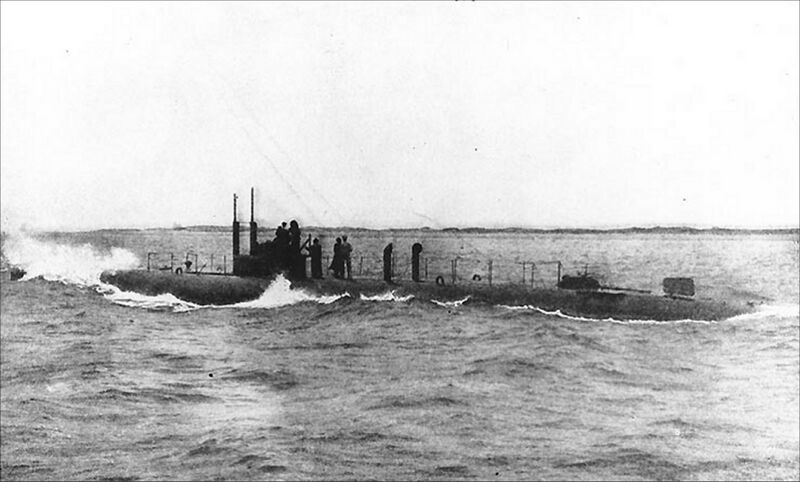
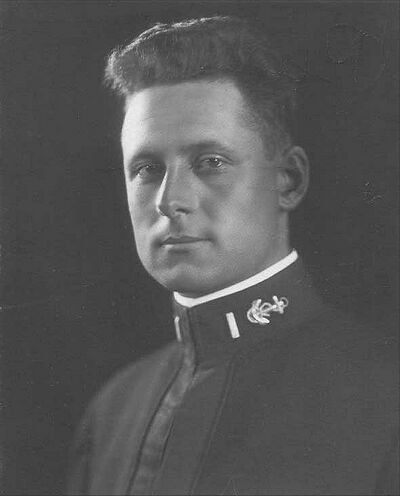
Paul Frederick Foster was born on March 25, 1889 in Wichita, Kansas. He received a senatorial appointment from the State of Idaho to the U.S. Naval Academy. Following graduation in 1911, he served in the armored cruiser Washington and the battleship Utah as a midshipman and, in March 1912, was commissioned as an Ensign. On 21-22 April 1914, Foster participated at the intervention at Vera Cruz, Mexico, leading his landing company with skill and courage. For his "distinguished conduct in battle", he was awarded the Medal of Honor.
After submarine instruction on board USS Prairie, he reported on board USS G-4. In March 1915, Foster was promoted to Lieutenant Junior Grade and, in early 1916, was placed in command of G-4.
Relocating to Ireland in December 1917, he was assigned to the submarine tender Bushnell in Bantry Bay, Ireland. Foster was temporarily promoted to Lieutenant in May 1918. While serving in Irish waters, he took command of the submarine L-2. Lieutenant Foster was awarded the Distinguished Service Medal for his role in the sinking of the German submarine UB-65 off the Irish coast on 10 July 1918.
